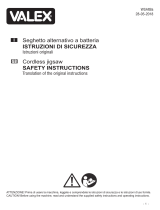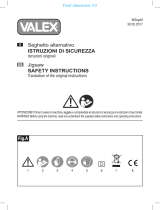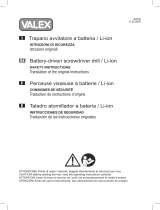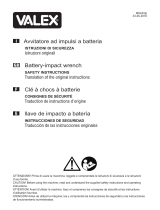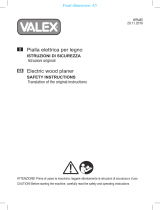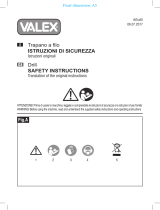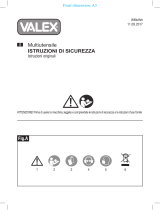La pagina si sta caricando...

- 1 -
Final dimension: A5
Sega a gattuccio a batteria
ISTRUZIONI DI SICUREZZA
Istruzioni originali
Cordless reciprocating saw
SAFETY INSTRUCTIONS
Translation of the original instructions
WSGatBa
10-10-2018
ATTENZIONE! Prima di usare la macchina, leggete e comprendete le istruzioni di sicurezza e le istruzioni d’uso fornite.
CAUTION! Before using the machine, read and understand the supplied safety instructions and operating instructions.

- 2 -
i
DESCRIZIONE MARCATURA E SIMBOLI (FIG.A)
Osservate con attenzione la simbologia della fig.A
e memorizzate il rispettivo significato. Una corretta
interpretazione dei simboli consente un uso più
sicuro della macchina.
1 Attenzione!
2 Leggete con attenzione tutte le istruzioni prima
dell’uso.
3 Indossare i guanti a protezione delle mani.
4 Indossare gli occhiali a protezione degli occhi
e cuffie antirumore. Indossare la maschera a
protezione delle vie respiratorie.
6 Doppio isolamento elettrico.
7 Solo per uso interno e in ambienti asciutti.
8 I rifiuti elettrici ed elettronici possono conte-
nere sostanze pericolose per l’ambiente e per
la salute umana; non devono pertanto essere
smaltiti con quelli domestici ma mediante una
raccolta separata negli appositi centri di raccolta
o riconsegnati al venditore nel caso di acquisto di
una apparecchiatura nuova analoga. Lo smalti-
mento abusivo dei rifiuti comporta l’applicazione
di sanzioni amministrative.
9 Le batterie incluse nell’apparecchio possono
essere smaltite assieme ad esso. Non gettate nel
fuoco e non disperdete nell’ambiente le batterie
esauste ma consegnatele agli appositi centri per
il loro smaltimento. Non smaltire assieme ai rifiuti
domestici.
10 Pericolo di esplosione. Mantenete l’apparecchio
e le batterie lontano da fonti di calore e dal fuoco.
11 Non esporre a temperature superiori a 50°C.
12 Marcatura di conformità CE
ATTENZIONE! Prima di usare questa macchina,
leggete tutte le istruzioni di sicurezza e le istruzioni
d’uso fornite. La mancata ottemperanza alle av-
vertenze e alle istruzioni può dare luogo a scosse
elettriche, incendi e/o lesioni serie.
La scrupolosa osservanza di queste avvertenze
con l’utilizzo dei mezzi di protezione individuale,
minimizzano i rischi di incidente ma non li elimi-
nano completamente.
Utilizzate l’utensile solo nei modi descritti in
queste istruzioni. Non utilizzatelo per scopi a cui
non è destinato.
Conservare tutte le avvertenze e le istruzioni per
riferimenti futuri.
6 7
1
12
4
32
8 9 10 11
A

- 3 -
AVVERTENZE DI SICUREZZA GENERALI
1) Sicurezza dell’area di lavoro
a) Tenere pulita e ben illuminata l’area di lavoro.
Le aree ingombre e/o poco illuminate possono
provocare incidenti.
b) Non far funzionare utensili elettrici in atmo-
sfere esplosive, ad esempio in presenza di
liquidi, gas, o polveri infiammabili. Gli utensili
elettrici creano scintille che possono provocare
l’accensione di polveri o fumi.
c) Tenere i bambini e gli estranei a distanza du-
rante il funzionamento di un utensile elettrico.
Le distrazioni possono far perdere il controllo
dell’utensile.
d) Mantenete in un luogo sicuro i sacchi di nylon
presenti nell’imballaggio. I sacchi possono pro-
vocare il soffocamento e i bambini non devono
entrarne in possesso.
e) Usate l’utensile in un luogo con un sufficiente
ricambio d’aria. L’areazione è necessaria per il
raffreddamento dell’utensile e per eliminare le
impurità nell’aria provocate dalla lavorazione.
f) Non far funzionare utensili elettrici all’aperto
in presenza di pioggia, nebbia, temporale, alte
e basse temperature, o in ambienti bagnati o
umidi. L’utilizzo in queste condizioni può provo-
care la folgorazione.
2) Sicurezza elettrica
a) La spina dell’utensile elettrico deve corri-
spondere alla presa. Mai modificare la spina
in alcun modo. Non utilizzare adattatori con
utensili elettrici dotati di messa a terra (a mas-
sa). Spine non modificate e prese corrispondenti
riducono il rischio di scossa elettrica.
b) Evitare il contatto del corpo con superfici
messe a terra o a massa quali tubi, radiatori,
cucine e frigoriferi. Se il vostro corpo è a terra
o a massa, il rischio di scossa elettrica aumenta.
c) Non esporre gli utensili elettrici alla pioggia
e non utilizzarli in luoghi umidi. L’ingresso di
acqua in un utensile elettrico aumenta il rischio
di scossa elettrica.
d) Non usurare il cavo. Non utilizzare mai il
cavo per trasportare, tirare o scollegare dalla
presa di rete l’utensile elettrico. Tenere il cavo
distante da calore, olio, bordi affilati o parti
in movimento. Cavi danneggiati o attorcigliati
aumentano il rischio di scossa elettrica.
e) Quando si aziona un utensile elettrico all’e-
sterno, usare un cavo di prolunga adeguato
per l’uso in esterni. L’uso di un cavo adeguato
riduce il rischio di scossa elettrica.
f) Utilizzare un’alimentazione elettrica protetta
da un interruttore differenziale (RCD). L’utilizzo
di un interruttore differenziale (RCD) riduce il
rischio di scossa elettrica. Consultate il vostro
elettricista di fiducia.
g) L’alimentazione elettrica deve corrispondere
a quella indicata sull’utensile elettrico. Una
alimentazione elettrica non idonea genera mal-
funzionamenti ed incidenti.
h) Verificate periodicamente il cavo di alimentazio-
ne elettrica. Non schiacciate o calpestate il cavo
di alimentazione elettrica. Un cavo danneggiato
è fonte di scosse elettriche.
i) In caso di dubbio in campo elettrico affida-
tevi ad tecnico specializzato di comprovata
esperienza. L’utilizzo dell’elettricità in modo non
sicuro è molto pericoloso per la vostra ed altrui
incolumità.
3) Sicurezza personale
a) Non distrarsi mai, controllare quello che si sta
facendo e usare il buon senso quando si azio-
nano utensili elettrici. Non azionare l’utensile
quando si è stanchi o sotto l’influsso di droghe,
alcol o medicinali. Un momento di disattenzione
durante l’azionamento di utensili elettrici può dare
luogo a serie lesioni personali.
b) Usare un’apparecchiatura di protezione per-
sonale. Indossare sempre protezioni per gli
occhi. Le apparecchiature di protezione quali ma-
schera antipolvere, protezioni per l’udito, guanti
di sicurezza, abbigliamento robusto e calzature
di sicurezza antiscivolo riducono la possibilità di
subire lesioni personali.
c) Prevenire le accensioni accidentali. Assicurar-
si che l’interruttore sia in posizione di spento
prima di collegare l’utensile alla rete elettrica,
prima di prenderlo o di trasportarlo. Traspor-
tare utensili elettrici con il dito sull’interruttore o
collegarli in rete con l’interruttore in posizione di
accensione può provocare incidenti.
d) Rimuovere qualsiasi chiave di regolazione
prima di accendere l’utensile elettrico. Una
chiave lasciata attaccata ad una parte rotante
dell’utensile elettrico può provocare lesioni
personali.
e) Non sbilanciarsi. Mantenere sempre la posizio-
ne e l’equilibrio appropriati. Questo permette di
controllare meglio l’utensile elettrico in situazioni
impreviste.
f) Vestirsi in modo appropriato. Non indossare ve-
stiti larghi o gioielli. Tenere capelli, indumenti e
guanti distanti dalle parti in movimento. Vestiti
larghi, gioielli o capelli lunghi possono impigliarsi
nelle parti in movimento.

- 4 -
g) Se sono previsti dispositivi da collegare ad
impianti per l’estrazione e la raccolta di pol-
vere, accertarsi che siano collegati e usati in
maniera appropriata. L’uso di questi dispositivi
può ridurre i rischi correlati alla polvere.
h) L’utilizzatore è responsabile verso terzi di
eventuali incidenti o danni a persone o cose.
Un uso improprio provoca incidenti e danni.
i) E’ vietato l’utilizzo a piedi nudi o con piedi e/o
mani bagnati/e. L’utilizzo in queste condizioni
può provocare la folgorazione.
l) La lavorazione di materiali nocivi alla salute
deve avvenire nel rispetto delle leggi vigenti.
Salvaguardate la propria ed altrui salute adottan-
do protezioni ed accorgimenti idonei.
m) Non avvicinarsi alle feritoie di espulsione
dell’aria di raffreddamento. L’aria generata può
contenere residui di lavorazione, piccole parti
dannose per le vie respiratorie e per gli occhi.
n) Non coprire e non infilare cose sulle feritoie
di raffreddamento. La mancata ventilazione
dell’utensile elettrico può generare un incendio.
Accedere a parti interne può danneggiare l’uten-
sile e provocare la folgorazione.
o) Non utilizzare l’utensile elettrico se le prote-
zioni (schermi, pannelli, sportelli ecc.) sono
aperti, danneggiati o mancanti. Le protezioni
correttamente installate salvaguardano la vostra
salute e consentono un utilizzo in sicurezza.
4) Uso e manutenzione degli utensili elettrici
a) Non forzare l’utensile elettrico. Usare l’utensile
adatto per l’operazione da eseguire. L’utensile
elettrico appropriato permette di eseguire il lavoro
con maggiore efficienza e sicurezza senza essere
costretti a superare i parametri d’uso previsti.
b) Non usare l’utensile elettrico se l’interruttore
di accensione e spegnimento non si aziona
correttamente. Qualsiasi utensile elettrico che
non può essere controllato con l’interruttore è
pericoloso e deve essere sottoposto a riparazioni.
c) Estrarre la batteria dall’utensile elettrico prima
di effettuare qualsiasi regolazione, cambiare
accessori o riporre gli utensili elettrici. Tali
misure di sicurezza preventiva riducono il rischio
di avvio accidentale dell’utensile elettrico.
d) Riporre utensili elettrici inutilizzati fuori della
portata dei bambini e non permetterne l’uso
a persone inesperte dell’utensile o che non
conoscano queste istruzioni. Gli utensili elettrici
sono pericolosi se utilizzati da persone inesperte.
e) Effettuare la manutenzione necessaria sugli
utensili elettrici. Verificare il possibile errato
allineamento o bloccaggio delle parti in movi-
mento, la rottura delle parti e qualsiasi altra
condizione che possa influenzare il funziona-
mento degli utensili elettrici. Se è danneg-
giato, far riparare l’utensile elettrico prima di
utilizzarlo. Numerosi incidenti sono provocati
proprio dal cattivo stato di manutenzione degli
utensili elettrici.
f) Mantenere puliti e affilati gli strumenti di
taglio. Strumenti di taglio in buone condizioni di
manutenzione e con bordi di taglio affilati sono
meno suscettibili di bloccarsi e sono più facili
da controllare.
g) Usare l’utensile elettrico, gli accessori e gli
elementi di taglio, in conformità con queste
istruzioni, tenendo conto delle condizioni di
lavorazione e dell’operazione da eseguire.
L’uso dell’utensile elettrico per operazioni diverse
da quelle previste può dare luogo a situazioni
pericolose.
h) Mantenete una distanza di sicurezza dalle
parti in movimento. Toccare parti in movimento
provoca lesioni serie.
i) Non modificate l’utensile elettrico. Togliere,
sostituire o aggiungere componenti non previsti
dalle istruzioni, è vietato ed annulla la garanzia.
l) Non abbandonare l’utensile elettrico in funzio-
ne. Spegnetelo prima di lasciarlo incustodito per
evitare possibili incidenti.
5) Assistenza
a) Far riparare l’utensile elettrico solo da tecnici
qualificati ed utilizzare solamente ricambi
identici. Ciò garantisce la costante sicurezza
dell’utensile elettrico.
b) Non tentare di riparare l’utensile elettrico o di
accedere ad organi interni. Interventi effettuati
da personale non qualificato e non autorizzato
dalla Ditta costruttrice può generare seri pericoli
ed annulla la garanzia.
c) Richiedete solo ricambi originali. L’utilizzo
di ricambi non originali può compromettere la
sicurezza dell’utensile elettrico.
AVVERTENZE DI SICUREZZA
DELLA SEGA A GATTUCCIO
a) Sostenere l’utensile per le impugnature isolate,
quando si effettua un’operazione nel corso
della quale l’organo di lavoro può venire in
contatto con dei cavi nascosti. Gli organi di
lavoro che vengono in contatto con un filo “in
tensione” possono mettere “in tensione” le parti
metalliche dell’utensile elettrico e provocare una
scossa elettrica (elettrocuzione) all’operatore.

- 5 -
b) Mantenete ben saldo l’utensile e adottare una
posizione di lavoro sicura. Gli sforzi provocati
dalla lavorazione provocano sollecitazioni che è
necessario contrastare con la vostra forza.
c) Se l’utensile si blocca durante l’utilizzo,
spegnerlo subito. Non forzate con operazioni
gravose per l’utensile.
d) Non lavorate materiali contenenti chiodi,
viti, cavi elettrici, fluidi, gas, ecc.. L’utensile si
danneggerà provocando pericolo per chi lo usa.
e) Assicurate il pezzo in lavorazione con una
morsa, morsetti o altro. Un pezzo trattenuto
con la mano può improvvisamente provocare
un incidente.
f) Non avviare l’utensile se la lama è a contatto
con il pezzo in lavorazione. In caso contrario è
possibile che subiate un contraccolpo a causa
dell’incastrarsi dell’elemento di taglio nel pezzo.
g) Avviare l’utensile prima di avvicinare la lama
alla superficie di taglio.
h) Durante l’operazione di taglio la piastra di
guida deve essere sempre ben appoggiata sul
pezzo. Mantenere l’utensile sollevato può pro-
vocare la rottura della lama ed un contraccolpo.
i) Per nessun motivo mettere le mani davanti l’u-
tensile, oppure sotto il materiale in lavorazione.
Non appoggiare il pezzo in lavorazione sulle
gambe. Toccare le parti in movimento dell’utensile
provoca lesioni gravi.
l) A taglio completato attendere l’arresto della
lama prima di estrarre l’utensile dal pezzo. In
questo modo si eviterà un possibile contraccolpo.
m) Attendere l’arresto della lama prima di posare
l’utensile. Un meccanismo di taglio esposto può
venire in contatto con la superficie con conse-
guente perdita di controllo e serie ferite.
n) Prima di montare o togliere gli accessori
(elemento di taglio ecc.), estrarre la batteria
dall’apparecchio. Ogni manutenzione deve av-
venire in sicurezza per evitare incidenti provocati
da un avvio improvviso.
o) Pulire con regolarità le aperture di ventilazione
dell’utensile elettrico. Il ventilatore del motore
attirerà la povere all’interno dell’alloggiamento e
un accumulo eccessivo di polvere può provocare
dei guasti o pericoli.
p) Non utilizzare lame usurate, piegate o dan-
neggiate.
q) Prima di eseguire il taglio verificate con un
opportuno strumento l’assenza di cavi elettrici
o tubazioni nascoste.
AVVERTENZE DI SICUREZZA
DELLA BATTERIA E DEL CARICABATTERIA
a
) Non smontare o lacerare l’involucro della batteria.
Non colpirla e non lasciarla cadere a terra. Batterie
danneggiate possono provocare seri pericoli.
b) Non esporre la batteria al calore o al fuoco. Non
esporre alla luce solare diretta. Non lasciarla all’interno
di veicoli. Non esporre a temperatura maggiore di 50°C.
Pericolo di esplosione.
c) Una batteria usata impropriamente può provocare
la fuoriuscita di vapori. Arieggiare il locale e consultare
un medico in caso di necessità.
d) Mettere le batterie e gli apparecchi elettrici fuori
dalla portata dei bambini. E’ buona norma mantenere i
bambini lontano dagli apparecchi elettrici.
e) Non inserite alcun oggetto metallico nel vano porta
batteria. Non depositate la batteria assieme ad alti
oggetti metalli (come la cassetta attrezzi) o assieme
ad altre batterie. Pericolo di generare un corto circuito
elettrico.
f) Utilizzare il caricabatterie in ambienti chiusi al
riparo dalla pioggia e dall’umidità. Prevenite possibili
folgorazioni elettriche.
g) Mantenete il caricabatterie sempre pulito. Polvere
e sporcizia impediscono la corretta ricarica.
h) Prima di ogni impiego controllare il caricabatterie,
il cavo e la spina. Non utilizzatelo in caso di danni o
guasti. Non aprire mai il caricabatterie e ripararlo soltanto
da personale qualificato e soltanto con pezzi di ricambio
originali.
i) Non utilizzare il caricabatterie su basi facilmente
infiammabili (come carta, tessuti, legno ecc.) oppure
in ambienti infiammabili o esplodenti. Prevenite possibili
incendi a seguito di surriscaldamenti.
l) Ricaricate la batteria con temperatura ambiente
compresa tra 10°C e 35°C. Temperature inferiori o su-
periori possono danneggiare la batteria e non permettere
la normale ricarica.
m) Scollegate il caricabatterie dalla rete rete elettrica
quando non lo usate. Non lasciate il caricabatterie
acceso con la batteria completamente carica. Prevenite
possibili incidenti.
n) È normale che il caricabatterie e la batteria si riscaldino
durante la fase di carica. E’ però necessario lasciarli
raffreddare entrambi, fino a temperatura ambiente, tra
due ricariche consecutive. Temperature elevate possono
provocare guasti o esplosione della batteria.
o) Sostituite le batterie che hanno terminato il loro ciclo
di utilizzo. Se la batteria si scarica molto velocemente
e/o i cicli di ricarica sono molto corti, è il segnale che si
sta esaurendo e va pertanto sostituita.
p) Utilizzate esclusivamente batterie di ricambio
originali, del tipo e con caratteristiche uguali a quella

- 6 -
fornita con l’utensile. L’uso di batterie di tipo o con vol-
taggio diverso possono danneggiare l’utensile e generare
pericoli. Acquistate esclusivamente ricambi originali.
q) Alcune batterie sono dotate di protezione termica
autoripristinante che inibisce la ricarica nel caso si
raggiungano temperature troppo elevate; in questo
caso il caricabatterie emetterà una luce lampeggiante
rossa. Rimuovere la batteria dal proprio alloggiamento
per alcuni minuti prima di reinserirla nel caricabatterie. La
carica riprenderà automaticamente quando la temperatura
sarà rientrata entro valori di sicurezza.
r) La tensione di alimentazione del caricabatterie deve
corrispondere a quella dichiarata sulla targa dati dello
stesso. Non utilizzate nessun altro tipo di alimentazione.
s) È consigliato l’uso di un apparecchio salvavita sulla
linea di alimentazione elettrica. Consultate il vostro
elettricista di fiducia.
t) Non danneggiare o calpestare il cavo di alimenta-
zione. Non trascinate il caricabatterie tirando il cavo.
Non tirate il cavo per estrarre la spina dalla rete di
alimentazione.
u) Un eventuali cavo di prolunga deve avere una se-
zione superiore a quella del cavo del caricabatteria e
dimensionato in base alla sua lunghezza.
v
) Se l’utensile elettrico si blocca perchè la
batteria è scarica, non insistere a premere il
pulsante di avvio altrimenti la batteria si guasta
irrimediabilmente.
AVVERTENZE DI SICUREZZA PER
LA RUMOROSITA’ E PER LE VIBRAZIONI
Il livello di rumorosità e di vibrazioni riportate nel foglio
allegato, sono valori medi di utilizzo dell’elettroutensile.
L’impiego di elementi di taglio diversi, materiali diversi,
assenza di manutenzione all’elettroutensile influiscono in
modo significativo nelle emissioni sonore e nelle vibra-
zioni. Di conseguenza adottate tutte le misure preventive
in modo da eliminare possibili danni dovuti ad un rumore
elevato e alle sollecitazioni da vibrazioni; indossate cuffie
antirumore, guanti antivibrazioni, effettuate delle pause
durante la lavorazione, mantenete efficiente l’elettrouten-
sile e gli accessori.
RISCHI RESIDUI
Queste illustrazioni mostrano i rischi principali nell’u-
so della macchina. Leggete attentamente il libretto
istruzioni della macchina.
Temperature elevate
provocano l’esplosione
delle batterie.
Non esponetele ai raggi
diretti del sole, non la-
sciatele dentro i veicoli,
non bruciatele.
Lancio di materiale e
polvere verso gli occhi
ed il corpo dell’ope-
ratore.
Indossate occhiali di
protezione e maschera
antipolvere.
Rumore elevato ge-
nerato dall’utensile.
Indossate cuffie a pro-
tezione dell’udito.
Lama e schegge/bave
che provocano ferite
alle mani.
Indossate guanti pro-
tettivi e mantenete una
distanza di sicurezza
dalla zona di taglio.
Rischio di scossa elet-
trica con pericolo di
morte. Non toccate le
parti in tensione elet-
trica e mantenete una
distanza di sicurezza.
Prima di ogni manu-
tenzione scollegate la
spina dalla presa di
alimentazione.

- 7 -
g
DESCRIPTION OF MARKING AND SYMBOLS (FIG.A)
Carefully observe the symbols in fig.A and memori-
se their respective meanings. Correct interpretation
of the symbols allows safer use of the machine.
1 Warning!
2 Carefully read all the instructions before use.
3 Wear protective gloves.
4 Wear safety goggles to protect your eyes, and
safety earmuffs. Wear a dust mask to protect your
respiratory tracts.
6 Double electrical insulation.
7 Only for indoor use and in dry places.
8 Electric and electronic waste may contain sub-
stances potentially hazardous to the environment
and human health. It should therefore not be di-
sposed of with household waste, but by means of
separate collection at special collection centres or
returned to the vendor in the event of purchasing
a new similar tool. Illegal disposal of waste will
result in administrative sanctions.
9 The batteries included in the tool can be disposed
of along with it. Do not dispose of used batteries in
fire and do not dispose of them in the environment,
but take them to special disposal centres. Do not
dispose of them with domestic waste.
10Risk of explosion. Keep the equipment and the
batteries far from heat sources and fire.
11Do not expose them to temperatures over 50°C.
12 CE Conformity Marking
WARNING! Before using this machine, read all
the enclosed safety instructions and instructions
for use. Failure to comply with the warnings and
instructions may cause electric shock, fire and/or
serious injuries.
Strict compliance with these warnings together with
the use of personal protective equipment minimises
the risk of accidents but does not completely rule
them out.
Only use the tool as instructed in this manual. Do
not use it for purposes for which it was not intended.
Store all warnings and instructions for future
reference.
GENERAL SAFETY WARNINGS
1) Safety in the work area
a) Keep the work area clean and well lit. Over-
crowded and/or badly lit areas may cause
accidents.
b) Do not operate power tools in explosive at-
mospheres, e.g. in the presence of flammable
liquids, gases or dusts. Power tools create
sparks which may ignite dust or fumes.
c) Keep children and unauthorised persons at a
distance when operating a power tool. Distrac-
tions may cause you to lose control of the tool.
d) Store the nylon packaging bags in a safe place.
Bags can cause suffocation and must be kept out
of the reach of children.
e) Use the tool in a well-ventilated area. Ventila-
tion is necessary for cooling the tool and for eli-
minating air impurities produced when working.
f) Do not operate power tools outdoors in the
presence of rain, fog, storms, high or low
temperatures, or in damp or wet environments.
Use under these conditions may result in electric
shock.
2) Electrical safety
a) The power tool plug must correspond to the
socket. Never modify the plug in any way. Do
not use adaptors with earthed (grounded) po-
wer tools. Unmodified plugs and suitable sockets
reduce the risk of electric shocks.
b) Avoid bodily contact with earthed or grounded
surfaces such as pipes, radiators, cookers
and refrigerators. If your body is earthed or
grounded, the risk of electric shock increases.
c) Do not expose power tools to rain and do
not use them in damp environments. Water
permeating into a power tool increases the risk
of electric shocks.
d) Do not let the cable become worn. Never use
the cable to transport, pull or disconnect the
power tool from the power supply socket. Keep
the cable away from heat, oil, sharp edges
or moving parts. Damaged or twisted cables
increase the risk of electric shocks.
e) When using a power tool outdoors, use an
extension cable suitable for outdoor use.
The use of a suitable cable reduces the risk of
electric shock.
f) Use an electric power supply protected by a
circuit breaker (RCD). The use of a suitable
residual current device (RCD) reduces the risk
of electric shock. Consult your local electrician.
g) The power supply must correspond to that in-
dicated on the power tool. An unsuitable power
supply generates malfunctioning and accidents.
h) Frequently check the power supply cable. Do
not crush or tread on the power supply cable.
A damaged cable causes electric shock.

- 8 -
i) For any doubts in the electrical field please
contact a qualified and experienced technician.
The unsafe use of electricity is very dangerous
for yours and other people’s safety.
3) Personal safety
a) Never allow yourself to be distracted. Control
what you are doing and use your common
sense when using power tools. Never use the
tool when you are tired or under the influence
of drugs, alcohol or medicines. A moment of
distraction when using power tools could cause
serious personal injuries.
b) Use personal protective equipment. Always
wear eye protection. Protective equipment such
as dust repelling masks, ear protections, safety
gloves, strong clothing or anti-slip safety shoes
reduce the possibility of personal injuries.
c) Prevent switching the tool on accidentally.
Make sure that the switch is in the off position
before connecting the tool to the electric po-
wer supply and before taking or transporting
it. Carrying power tools with your finger on the
switch or connecting them to the electric power
supply with the switch in the on position can
cause accidents.
d) Remove any adjustment key before switching
on the power tool. Any key or spanner left at-
tached to a rotating part of the power tool may
cause personal injuries.
e) Do not lose your balance. Always keep an
appropriate position and balance. This allows
better control of the power tool in unexpected
situations.
f) Wear appropriate clothing. Do not wear loose
clothing or jewellery. Keep hair, clothing and
gloves away from moving parts. Loose clothing,
jewellery or long hair may get entangled in the
moving parts.
g) If any devices to be connected to dust extrac-
tion and collection systems are provided for,
make sure that they are connected and used
appropriately. The use of these devices may
reduce the risks connected with dust.
h) The user is responsible for other people as far
as accidents or damage to people or property
are concerned. Improper use causes accidents
and damage.
i) Never use with bare feet or wet feet/hands.
Use under these conditions may result in electric
shock.
l) The machining of materials which are hazar-
dous to health must be in compliance with
applicable laws. Protect your and other people’s
health using suitable protections and devices.
m) Do not get close to the cooling air venting
slots. The air generated may contain machining
residuals and small parts that are harmful for
your respiratory tracts and eyes.
n) Do not cover or insert anything in the cooling
vents. Unsuitable ventilation of the power tool
may start a fire. Accessing the internal parts
may damage the power tool and result in electric
shock.
o) Do not use the power tool if the guards (scre-
ens, panels, doors, etc.) are open, damaged or
missing. Correctly installed guards protect your
health and allow for safe use.
4) Use and maintenance of power tools
a) Do not force the power tool. Use a suitable
tool for the operation to be carried out. An
appropriate power tool can perform the work
with higher efficiency and safety without having
to exceed the parameters intended for its use.
b) Do not use the power tool if the on/off switch
does not work properly. Any power tool that
cannot be controlled by its switch is dangerous
and must be repaired before use.
c) Take out the battery from the power tool before
making any adjustments, replacing accessories
or storing the power tool. These preventive
safety measures reduce the risk of accidental
start of the power tool.
d) Store unused power tools out of reach of
children and do not allow them to be used by
any unskilled people or who are not aware of
these instructions. Power tools are dangerous
if used by unskilled people.
e) Carry out the required maintenance on power
tools. Check any possible misalignment or
locking of the moving parts, any breakage of
the parts and any other condition that may
affect the operation of power tools. If there
is any damage, the power tool must be fixed
before use. Numerous accidents are caused by
improper maintenance of power tools.
f) Keep the cutting elements clean and sharpened.
Cutting tools in good conditions and with sharp
edges are less likely to lock and can be controlled
more easily.
g) Use the power tool, accessories and cutting
elements in accordance with these instruc-
tions, considering the work conditions and the
operation to be performed. Using the power
tool for operations other than those for which
it is intended may cause dangerous situations.
h) Keep a safe distance from moving parts. Tou-

- 9 -
ching moving parts causes serious injury.
i) Do not modify the power tool. Taking off, repla-
cing or adding components not included in the
instructions is prohibited and causes the warranty
to become null and void.
l) Do not leave the power tool running unattended.
Turn it off before leaving it unattended in order to
prevent any accidents.
5) Support
a) The power tool must be repaired exclusively
by qualified technicians and only identical
spare parts should be used. This guarantees
the constant safety of the power tool.
b) Do not attempt to repair the power tool or
access its internal parts. Repairs carried out
by persons unqualified and unauthorised by the
manufacturer can create serious hazards and
void the warranty.
c) Request only original spare parts. The use of
non-original spare parts may compromise the
safety of the power tool.
SAFETY WARNINGS
FOR KEYHOLE SAW
a) Grip the tool by the insulated handgrips, when
performing an operation during which the tool
could come into contact with hidden cables.
If the work devices come into contact with a
“live” conductor, the metal parts of the power
tool could become “live” and cause an electric
shock (electrocution) to the operator.
b) Keep the tool stable and stand in a safe work
position. The strains caused by working lead
to stress which must be contrasted with your
force.
c) If the tool stops during use, switch it off im-
mediately. Do not force difficult operations for
the tool.
d) Do not work with materials containing nails,
screws, electric cables, liquids, gases, etc.
The tool will be damaged causing danger to
those using it.
e) Secure the workpiece with a vice, clamps or
another device. A workpiece held by hand can
suddenly cause an accident.
f) Do not switch on the tool if the blade is in
contact with the workpiece. Otherwise, you
may undergo a kickback because the cutting
element is stuck in the workpiece.
g) Switch the tool on before approaching the
blade to the cutting surface.
h) During the cutting operation, the guide panel
must always be firmly resting on the workpiece.
Keeping the tool lifted may break the blade and
cause a kickback.
i) Under no circumstances should you put your
hands in front of the tool, or below the workpie-
ce. Do not lay the workpiece on your legs.
Touching the moving parts of the tool causes
serious injury.
l) Once you have finished cutting, wait for the
blade to come to a standstill before removing
the tool from the workpiece. In this way, you
can avoid a possible kickback.
m) Wait for the blade to come to a standstill be-
fore laying the tool down. An exposed cutting
mechanism could come into contact with the
surface with subsequent loss of control and
serious injuries.
n) Before installing or removing accessories
(cutting element, etc.), take the battery out of
the tool. Any maintenance must be performed
safely in order to prevent accidents caused
by unexpectedly switching the power tool on.
o) Regularly clean the vents of the power tool.
The motor fan will draw dust inside the casing
and an excessive accumulation of dust may
cause damage or injury.
p) Do not use worn, bent or damaged blades.
q) Before cutting, check using an appropriate tool
that there are no hidden wires or pipes.
SAFETY WARNINGS
FOR THE BATTERY AND BATTERY CHARGER
a) Do not disassemble or tear the battery case. Do not
hit it or drop it. Damaged batteries can cause serious
danger.
b) Do not expose the battery to heat or fire. Do not
expose it to direct sunlight. Do not leave it inside
vehicles. Do not expose it to temperatures over 50°C.
Risk of explosion.
c) A battery used incorrectly can cause vapours to leak
out. Ventilate the room and consult a doctor if necessary.
d) Keep batteries and electrical equipment out of the
reach of children. It is good practice to keep children
away from electrical equipment.
e) Do not put any metal objects into the battery com-
partment. Do not put the battery away with other metal
objects (like the tool box) or with other batteries. Risk
of generating a short circuit.
f) Use the battery charger in closed rooms sheltered
from rain and humidity. Prevent possible electric shocks.
g) Always keep the battery charger clean. Dust and dirt
prevent correct charging.
h) Before use, always check the battery charger, cable
and plug. Do not use it in the event of damage or faults.

- 10 -
Never open the battery charger and only have it repaired
by qualified staff and only with original spare parts.
i) Do not use the battery charger on easily flammable
surfaces (e.g. paper, fabric, wood, etc.) or in flamma-
ble or explosive environments. Prevent any fires due
to overheating.
l) Charge the battery at room temperature between
10°C and 35°C. Lower or higher temperatures can da-
mage the battery and inhibit normal charging.
m) Unplug the battery charger when not in use. Do not
leave the battery charger switched on with the battery
completely charged. Prevent possible accidents.
n) It is normal for the battery charger and the battery
to heat up while being charged. However, both must be
left to cool down to room temperature between conse-
cutive charging. High temperatures can cause damage
or explosion of the battery.
o) Replace batteries that have come to the end of their
use cycle. If the battery loses its charge very quickly and/
or the charging cycles are very short, it means that it is
nearly dead and therefore needs replacing.
p) Only replace it with original batteries, of the same
type and characteristics as the one supplied with the
tool. The use of batteries of different types and voltages
can damage the tool and cause danger. Only buy original
spare parts.
q) Some batteries have auto reset thermal protection,
which prevents charging should the temperature be
too high; in this case the battery charger will emit a
flashing red light. Remove the battery from its housing
for a few minutes before putting it back in the battery char-
ger. The charging will start again automatically when the
temperature has returned within the safe range of values.
r) The power supply voltage of the battery charger must
match that indicated on the technical data nameplate.
Do not use any other type of power supply.
s) It is advisable to install a trip switch on the electrical
power supply line. Consult your local electrician.
t) Do not damage or tread on the power supply cable.
Do not pull the battery charger by the cable. Do not pull
the cable in order to unplug it from the power supply.
u) Any extension cable must have a higher section than
that of the battery charger cable and correctly sized
according to its length.
v) If the power tool stops because the battery is flat,
do not keep pressing the start button, or the battery
will be irreparably damaged.
SAFETY WARNINGS FOR
NOISE AND VIBRATIONS
The level of noise and vibrations shown on the attached
sheet are average values for the use of the power tool.
The use of different cutting elements, different materials,
the use or not of the percussion function and lack of
maintenance on the power tool significantly affect the
sound emissions and vibrations. Therefore, adopt all the
preventive measures necessary to eliminate any possible
damage due to loud noises and strain from vibrations;
wear earmuffs, anti-vibration gloves, take breaks while
working, and ensure the power tool and its accessories
are kept in good working order at all times
RESIDUAL RISKS
These illustrations show the main risks involved with
using the machine. Read the machine instruction
manual carefully.
High temperatures
cause the batteries to
explode.
Do not expose them
to direct sunlight, do
not leave them inside
vehicles and do not
burn them.
Material and dust flying
towards the operator’s
eyes and body.
Use eye protection and
an anti-dust mask.
Loud noise generated
by the tool. Use ear
protection.

- 11 -
Blade and splinters/burrs
could injure hands.
Wear protective gloves
and keep a safe distan-
ce from the cutting
area.
Risk of electric shock
and danger of death.
Do not touch the elec-
trically live parts and
keep a safe distance.
Before any maintenan-
ce operations, unplug
the machine from the
power supply.
/
